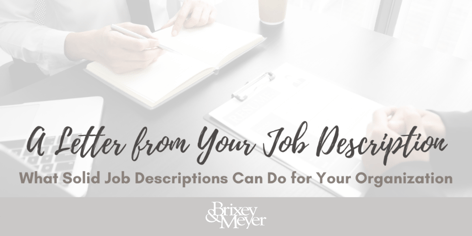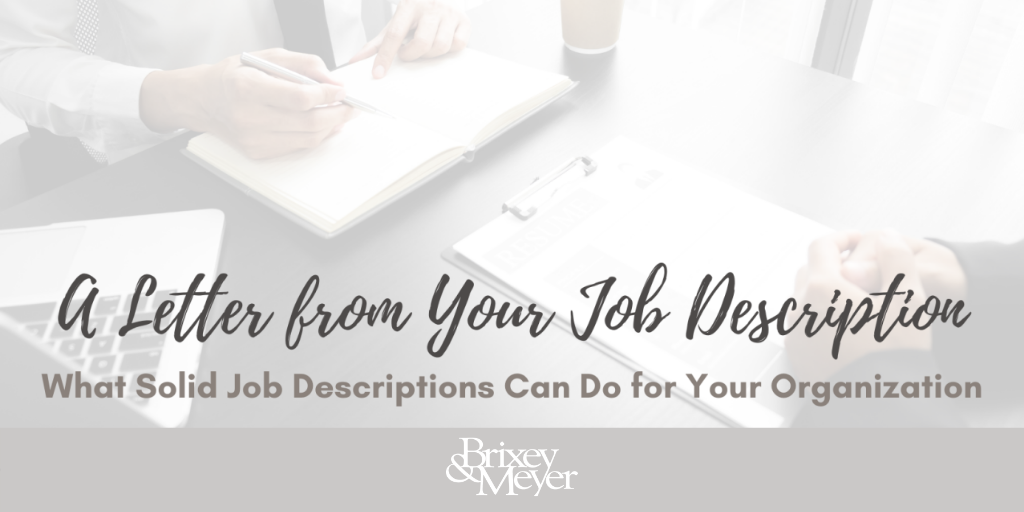A Letter from Your Job Description: What Solid Job Descriptions Can Do for Your Organization
 Greetings! It’s me your Job Descriptions. A few months ago, my cousin sent you a letter. As you recall, his name is Employee Handbook. After speaking with him, it sounded like he was helpful. In fact, he encouraged me to write you a similar letter. Now, please do not take offense or ignore me. I know I am not the center of attention at strategic planning sessions nor do employees discuss me at happy hours. Just like my cousin, we tend to age with few revisions or little attention.
Greetings! It’s me your Job Descriptions. A few months ago, my cousin sent you a letter. As you recall, his name is Employee Handbook. After speaking with him, it sounded like he was helpful. In fact, he encouraged me to write you a similar letter. Now, please do not take offense or ignore me. I know I am not the center of attention at strategic planning sessions nor do employees discuss me at happy hours. Just like my cousin, we tend to age with few revisions or little attention.
Please take a few minutes to consider how I can add value to your organization.
A great job description will…
1. Highlight the position’s role in nurturing the culture (CULTURE).
Every person, policy, structure, and governance decision plays a role into building a culture. What a person does, how s/he does it, and where it is done affects culture. Culture is not just a feeling. Rather, it is a complex ecosystem in which work takes place. Each and every decision, new hire, and happening strengthens or weakens the culture. Every person in the organization has a unique role influencing the culture...either positively or negatively. For instance, when a position is not aligned to organizational aims, it creates confusion. Confusion seeps into the culture creating negativity. On the other hand, when positional alignment exists between a position and organizational outcomes, it creates clarity. Clarity feeds into the culture creating positivity. Magnify this over and over again, and you will find the makings of either a negative or positive culture.
When job descriptions include accepted behaviors, clarity exists. Do not keep this just on paper, though. Create solid performance management and corrective action plans to reinforce these as well! Alignment is key! A great job description helps align what a person should do with what the organization wants to accomplish.
Great cultures do not just happen! Great cultures exist due to people doing intentional work aligned to intentional outcomes.
2. Align the position’s expectations to the needed organizational outcomes (OPERATIONS)
Your organization provides a service or a product. To stay in business, you need to sell this service or product. I know this is a simplistic comment, but it is important! When was the last time you did audited your people to see if their behaviors, actions, and outputs connect to what you produce? Is there alignment? Does the front desk receptionist know exactly how his job connects to what you produce? Does your sales person have specific job duties that align to realities within the production process? When a job description has the right job duties listed, it begins to set the right expectations. Even better is when success is defined for each duty.
3. Attract the right person and repel the wrong person for the role (TALENT)
Does your job description paint an accurate picture of the role? Even more important, is there language in it that screams excitement to the right person? Great job descriptions should tell a story. This story is about the position and how it helps the organization do great things. This story is about the position and how it helps the organization do great things. The right person will find it compelling. The wrong person will find it repelling. That is good!
Here is an exercise. Go to a job board (e.g.—Indeed, CareerBuilder, Monster), and type in a job title. My guess is that most companies have similar job ads, which directly mirror the job description. On a side note, a job ad is not the same thing as a job description, but that is for another post! When you read the job ad, you will find bland and half-baked descriptions of the role. This does not set your organization apart nor does it paint an accurate picture of the job within YOUR organization. In turn, the same candidates apply to the same listing of jobs. Since the job description does little to highlight the culture (as it relates to the given position), organizational “fit” becomes a difficult thing to measure.
4. Protect the organization from legal and compliance pitfalls (LEGAL/COMPLIANCE)
This benefit is often seen in a job description, but it should not be overlooked! Organizations save themselves many dollars and distractions by spelling out job requirements, accommodations, and other legal language. Be sure to remember various laws related to at-will employment, implied contracts, workers’ compensation, Americans with Disabilities, et cetera.
When a person signs the job description, s/he is agreeing to its expectations. These include legal and compliance matters. Save your self time in litigation and governmental investigations by creating a legally solid document!
I am hopeful that you did not stop reading and delete this message. If you are still reading, let’s figure out a time to meet. I am open to meeting face-to-face, but if we need to schedule a Zoom call, let me know. I know I am not the most exciting aspect of your business, but I promise I can and will promote the things you value and help you build a bigger, better, faster, and strong organization.
Sincerely,
Your Job Description(s)
Need assistance with addressing short and long term HR needs for your business? Contact me at steve.black@brixeyandmeyer.com, and we will address them proactively.
Disclaimer: This blog is not legal advice, but merely informed opinion or general information meant for no particular purpose. Issues addressed in this blog often implicate federal, state, and local labor and employment laws. This blog is not intended as a substitute for legal advice. Readers should consult labor and employment counsel to determine whether their particular policies, procedures, decisions, or courses of action comply with such laws.

